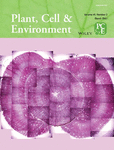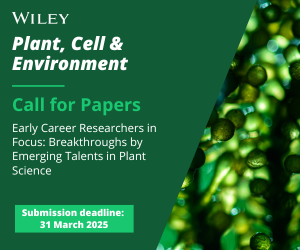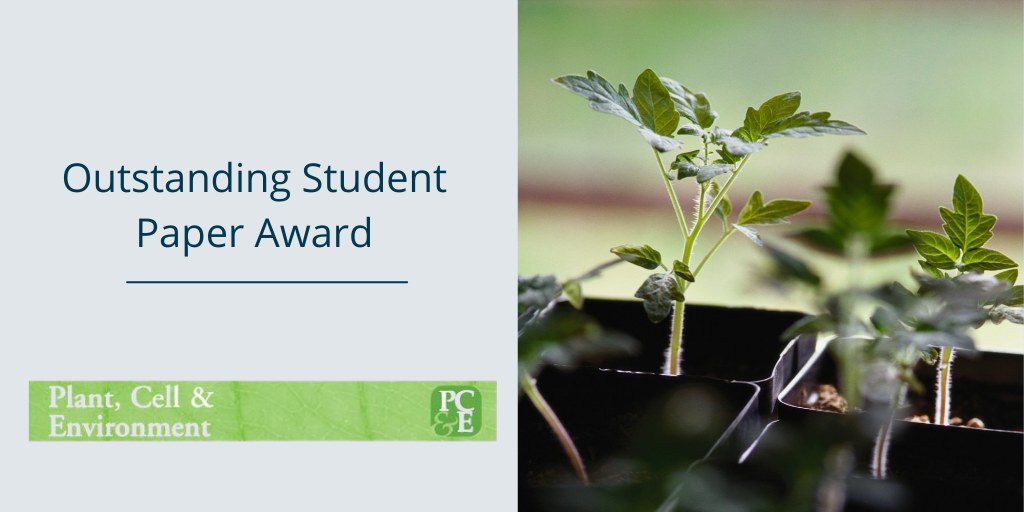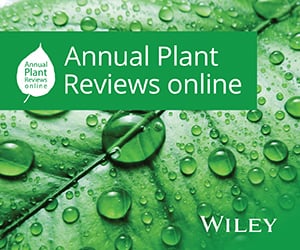Journal list menu
Export Citations
Download PDFs
COVER IMAGE
COVER IMAGE
- Page: i
- First Published: 18 February 2021
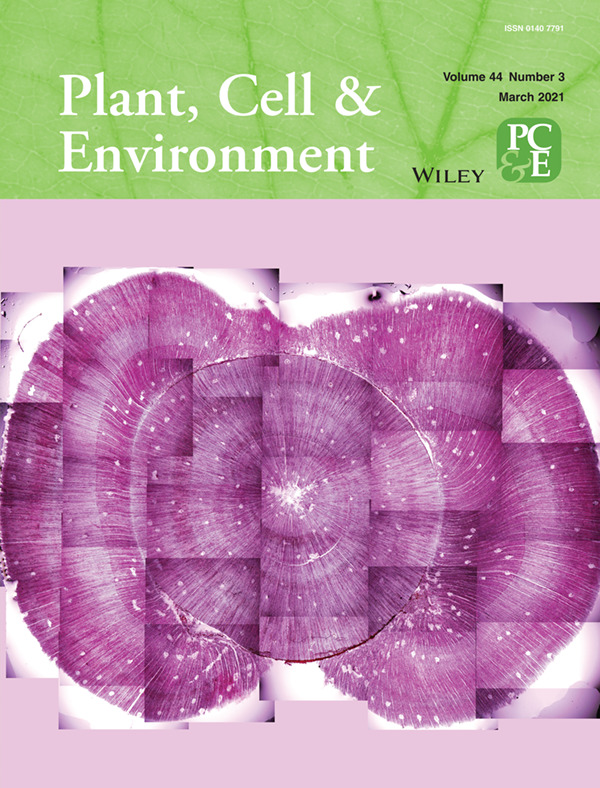
The cover image is based on the Original Article Short- and long-term effects of fire on stem hydraulics in Pinus ponderosa saplings by Raquel Partelli-Feltrin et al., https://doi.org/10.1111/pce.13881.
ISSUE INFORMATION
REVIEWS
Light acts as a stressor and influences abiotic and biotic stress responses in plants
- Pages: 645-664
- First Published: 15 November 2020
Light can be stressful for plants and the light environment (quality, quantity and duration of illumination) influences the responses of plants to biotic and abiotic stresses through diverse connections between the light and stress signaling pathways.
Implications of ionizing radiation on pollen performance in comparison with diverse models of polar cell growth
- Pages: 665-691
- First Published: 30 October 2020
The comparison of ionizing radiation effects on performance of diverse pollen species with other models of polar cell growth demonstrates that these reduced haploid gametophytic systems are extremely radiation-tolerant, much more than related sporophytes or animal tissues.
COMMENTARY
Physiological responses to fire that drive tree mortality
- Pages: 692-695
- First Published: 07 January 2021
This article comments on: Short- and long-term effects of fire on stem hydraulics in Pinus ponderosa saplings
ORIGINAL ARTICLES
Short- and long-term effects of fire on stem hydraulics in Pinus ponderosa saplings
- Pages: 696-705
- First Published: 05 September 2020
One major unknown of physiological ecology is how fire kills trees. Understanding how fire affects the physiological responses is crucial to better predict post-fire tree mortality and inform management practices. In this study, water transport and vulnerability to drought-induced embolism was not affected in Pinus ponderosa saplings one day post-fire. However, surviving saplings were more vulnerable to cavitation 21-months post-fire. This suggests that saplings that survive fire may be more less drought resistant than unburned saplings.
Comprehensive analysis of the isomiRome in the vegetative organs of the conifer Pinus pinaster under contrasting water availability
- Pages: 706-728
- First Published: 12 December 2020
The present work provides a first characterization of the rich and variable isomiRome encoded by a conifer genome. Results highlight a differential distribution of the isomiRome in different vegetative organs and under contrasting water availability, and potentially targeting transcripts controlling key physiological responses to drought.
Bioenergy sorghum maintains photosynthetic capacity in elevated ozone concentrations
- Pages: 729-746
- First Published: 27 November 2020
Sorghum (Sorghum bicolor L.), a widely adapted and highly productive C4 grass, has potential as a bioenergy feedstock. In this study, we found that sorghum genotypes exhibit significant variability in plant functional traits, but a similar response to O3. Elevated O3 did not alter net CO2 assimilation (A), stomatal conductance (gs) and chlorophyll fluorescence in multiple genotypes of sorghum in both field and chamber experiments. We suggest that sorghum could be used to enhance biomass production for bioenergy in O3 polluted regions.
Leaf photosynthetic and anatomical insights into mechanisms of acclimation in rice in response to long-term fluctuating light
- Pages: 747-761
- First Published: 20 November 2020
Fluctuating light (FL) conditions are very common in natural environments. It is unclear how rice (Oryza sativa L.) plants integrate multiple physiological changes to acclimate to long-term FL. Through systematic analysis of physiological and anatomical changes, we revealed that grana membrane stacking, electron flow, ATP synthase activity and NPQ regulation are the major processes determining the growth performance of rice under long-term FL conditions.
CAM-physiology and carbon gain of the orchid Phalaenopsis in response to light intensity, light integral and CO2
- Pages: 762-774
- First Published: 27 November 2020
In CAM-species Phalaenopsis the malate decarboxylation rate responded to light intensity, but in the long term it was the light integral during phase III that regulated the malate pool. Elevated CO2 enhanced diel carbon gain, both in CAM-phase IV and I, proving that neither storage capacity, nor substrate (PEP) were limiting factors.
NtMYB12a acts downstream of sucrose to inhibit fatty acid accumulation by targeting lipoxygenase and SFAR genes in tobacco
- Pages: 775-791
- First Published: 22 November 2020
The flavonol-specific regulator MYB12 affects the accumulation of several other metabolites in various plant species. Multiple regulatory functions of MYB12 and the regulation of its activity need to be further studied. Here, we showed that NtMYB12a inhibits the accumulation of FA in tobacco leaves and seeds via promoting the transcription of NtSFAR4, NtLOX6, NtLOX5, and NtGDSL2 genes. Sucrose stimulates the transcription of NtMYB12a, which acts downstream of sucrose signal to regulate FA metabolism.
Modelling the physiological relevance of sucrose export repression by an Flowering Time homolog in the long-distance phloem of potato
- Pages: 792-806
- First Published: 13 December 2020
We describe the construction of a biophysically realistic, potato specific model for long distance phloem-mediated sucrose transport. Using this model we show that SP6A dependent reduction of SWEET11 mediated phloem sucrose export may significantly enhance tuber yield.
Naturally occurring circadian rhythm variation associated with clock gene loci in Swedish Arabidopsis accessions
- Pages: 807-820
- First Published: 11 November 2020
Circadian rhythms in Swedish Arabidopsis accessions vary with both geographical regions and population structure. Through GWA mapping, we find naturally occurring period length variation is associated with a single SNP within COR28. Finally, we show that phenotypic tails for period remain diverged at reduced temperatures and follow a distinctive arrow-shaped trend.
Diurnal dynamics of the Arabidopsis rosette proteome and phosphoproteome
- Pages: 821-841
- First Published: 05 December 2020
The manuscript provides quantitative information of diurnal changes in the accumulation and phosphorylation of proteins in Arabidopsis thaliana rosettes grown in a 12 hr photoperiod. The highly resolved time-scale of the datasets offers new proteome-level insights for future targeted studies.
The transcriptional repressor OsPRR73 links circadian clock and photoperiod pathway to control heading date in rice
- Pages: 842-855
- First Published: 29 December 2020
PRR proteins involve in circadian clock in plants and play important roles in regulating flowering. It is not clear the function of OsPRR73 in rice. This study demonstrated that OsPRR73 links circadian clock and photoperiod pathway to control heading date by binding to the Ehd1 promoter in rice.
Soybean CHX-type ion transport protein GmSALT3 confers leaf Na+ exclusion via a root derived mechanism, and Cl− exclusion via a shoot derived process
- Pages: 856-869
- First Published: 15 November 2020
GmSALT3 improves soybean salt tolerance. Here, using heterologous expression, we found GmSALT3 is a functional ion transporter, and, in planta that it confers shoot salt exclusion through root-based Na+ xylem exclusion and shoot-based Cl− exclusion via phloem derived Cl− recirculation.
Acclimatisation of guard cell metabolism to long-term salinity
- Pages: 870-884
- First Published: 29 November 2020
Guard cell metabolism differentially responds to altered ion composition resulting from salt stress (NaCl) compared with whole leaf tissue in Vicia faba L.
Dynamic thermal imaging confirms local but not fast systemic ABA responses
- Pages: 885-899
- First Published: 08 December 2020
We used dynamic leaf temperature imaging to detect local and systemic responses to ABA in Arabidopsis and barley. We found no fast systemic ABA-induced stomatal closure in Arabidopsis (but detected a slow systemic response) nor effect of exogenous nitrate on ABA-induced stomatal closure in barley.
Differential localization of flavonoid glucosides in an aquatic plant implicates different functions under abiotic stress
- Pages: 900-914
- First Published: 10 December 2020
Individual flavonoid glucosides have distinct cellular and subcellular locations in the photosynthetic tissue layers of the giant duckweed and promote duckweed fitness under different abiotic stresses.
Cell wall modification by the xyloglucan endotransglucosylase/hydrolase XTH19 influences freezing tolerance after cold and sub-zero acclimation
- Pages: 915-930
- First Published: 14 November 2020
xth19 mutant had reduced freezing tolerance after cold or sub-zero acclimation. Microscopic and biochemical characterization of the cell wall indicated altered xyloglucan deposition in xth19 after sub-zero acclimation showing the importance of cell wall remodelling for increased freezing tolerance.
The intracellular ROS accumulation in elicitor-induced immunity requires the multiple organelle-targeted Arabidopsis NPK1-related protein kinases
- Pages: 931-947
- First Published: 12 December 2020
Upon danger sensing, the subcellular localization of the Arabidopsis NPK1-related Protein kinases changes and coincides with sites of elicitor-induced ROS accumulation, such as plastids and nuclei. anp mutants do not accumulate ROS in those organelles hinting that ANPs are required for this process.
Overexpression of the homoterpene synthase gene, OsCYP92C21, increases emissions of volatiles mediating tritrophic interactions in rice
- Pages: 948-963
- First Published: 25 October 2020
This study characterizes first rice homoterpene biosynthesis gene OsCYP92C21. The results demonstrate the homoterpene emission is dependent on the precursor pools and can be significantly enhanced without any induction through subcellular targeting gene expression and genetic introgression.
Ethylene is a local modulator of jasmonate-dependent phenolamide accumulation during Manduca sexta herbivory in Nicotiana attenuata
- Pages: 964-981
- First Published: 20 November 2020
Herbivory-elicited ethylene acts as a local enhancer of the production of jasmonate/MYB8-dependent phenolamides during the defence response of Nicotiana attenuata leaves against herbivory by the lepidopteran larvae, Manduca sexta.
Long non-coding RNAs associate with jasmonate-mediated plant defence against herbivores
- Pages: 982-994
- First Published: 14 November 2020
The role of long non-coding RNAs (lncRNAs) in plant defence against herbivores has not yet been explored. Here we show that the transcripts of more than 500 lncRNAs are up-regulated after herbivore-elicitation, some of them are associated with jasmonate-mediated herbivore resistance.




